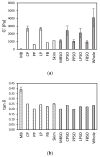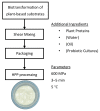A Novel Approach to Structure Plant-Based Yogurts Using High Pressure Processing
- PMID: 32824140
- PMCID: PMC7466357
- DOI: 10.3390/foods9081126
A Novel Approach to Structure Plant-Based Yogurts Using High Pressure Processing
Abstract
Current plant-based yogurts are made by the fermentation of plant-based milks. Although this imparts fermented flavors and probiotic cultures, the process is relatively longer and often leads to textural issues. The protein content of these plant-based yogurts is also lower than their dairy counterparts. To overcome these challenges, this paper explores the high pressure processing (HPP) of plant protein ingredients as an alternative structuring strategy for plant-based yogurts. Using mung bean (MB), chickpea (CP), pea (PP), lentil (LP), and faba bean (FB) proteins as examples, this work compared the viscosity and viscoelastic properties of high pressure-structured (600 MPa, 5 min, 5 °C) 12% (w/w) plant protein gels without, and with 5% (w/w) sunflower oil (SO) to commercial plain skim and whole milk Greek yogurts and discussed the feasibility of using HPP to develop plant-based yogurts. HPP formed viscoelastic gels (G' > G'') for all plant protein samples with comparable gel strength (G'~102-103 Pa; tan δ~0.2-0.3) to commercial dairy yogurts. The plant protein gel strength decreased in the order: CP~CPSO~LP~LPSO > MBSO~PPSO~FB~FBSO > PP >> MB. Modest addition of sunflower oil led to little change in viscoelastic properties for all plant protein samples except for MB and PP, where gel strength increased with incorporated oil. The emulsion gels were also more viscous than the hydrogels. Nonetheless, the viscosity of the plant protein gels was similar to the dairy yogurts. Finally, a process involving separate biotransformation for optimized flavor production and high pressure processing for consistent texture generation was proposed. This could lead to high protein plant-based yogurt products with desirable texture, flavor, and nutrition.
Keywords: emulsion gels; high pressure processing; hydrogels; plant proteins; plant-based yogurts.
Conflict of interest statement
The authors declare no conflict of interest.
Figures






References
-
- Day L. Proteins from land plants—Potential resources for human nutrition and food security. Trends Food Sci. Technol. 2013;32:25–42. doi: 10.1016/j.tifs.2013.05.005. - DOI
-
- Kizer L., Renninger N., Schelle M. Dairy Product Analogs and Processes for Making Same. 16/095,117. U.S. Patent. 2019 May 16;
-
- Margolis G., Myers S., Newbold D. Manufacturing of Plant-Based Yogurt. 16/293,282. U.S. Patent. 2019 Sep 12;
LinkOut - more resources
Full Text Sources
Other Literature Sources
Miscellaneous

